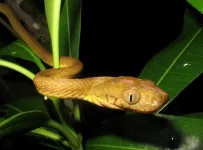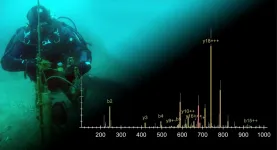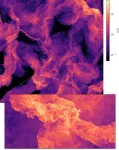(Press-News.org) A team of researchers from Colorado State University and the University of Cincinnati have discovered a new mode of snake locomotion that allows the brown tree snake to ascend much larger smooth cylinders than any previously known behavior.
This lasso locomotion, named because of a lasso-like body posture, may contribute to the success and impact of this highly invasive species. It allows these animals to access potential prey that might otherwise be unobtainable and may also explain how this species could climb power poles, leading to electrical outages.
Researchers said they hope the findings will help people protect endangered birds from the snakes.
The study, "Lasso locomotion expands the climbing repertoire of snakes," is published Jan. 11 in Current Biology.
'Unexpected' locomotion discovered on U.S. island territory of Guam
For nearly 100 years, all snake locomotion has been traditionally categorized into four modes: rectilinear, lateral undulation, sidewinding and concertina.
This new discovery of a fifth mode of locomotion was the unexpected result of a project led by CSU Emeritus Professor Julie Savidge aimed at protecting the nests of Micronesia starlings, one of only two native forest species still remaining on Guam.
Savidge, part of the Department of Fish, Wildlife and Conservation Biology at CSU, said that the brown tree snake has decimated forest bird populations on Guam, where the discovery took place. The snake, which is nocturnal, was accidentally introduced to Guam in the late 1940s or early 1950s. Shortly thereafter, bird populations started to decline.
The scientist conducted her doctoral dissertation research on Guam in the 1980s and identified the snake as the culprit for the loss of birds. The animal has caused extensive damage and is responsible for numerous power outages across the island each year.
"Most of the native forest birds are gone on Guam," said Savidge. "There's a relatively small population of Micronesian starlings and another cave-nesting bird that has survived in small numbers. The starling serves an important ecological function by dispersing fruit and seeds which can help maintain Guam's forests."
CSU's Tom Seibert, co-author and emeritus faculty, said the team was attempting to use a three-foot long metal baffle to keep the brown tree snakes from climbing up to bird boxes. These same baffles have been used to keep other snakes and raccoons away from nest boxes in the yards of bird-watchers. But this new study suggests these might pose little obstacle to brown tree snakes.
"We didn't expect that the brown tree snake would be able to find a way around the baffle," he said. "Initially, the baffle did work, for the most part. We had watched about four hours of video and then all of a sudden, we saw this snake form what looked like a lasso around the cylinder and wiggle its body up."
Seibert said that he and CSU biologist Martin Kastner almost fell out of their chairs when they first observed this new form of locomotion.
"We watched that part of the video about 15 times" Seibert said. "It was a shocker. Nothing I'd ever seen compares to it."
Brown tree snake is a 'champion climber'
To confirm the discovery, the team subsequently reached out to University of Cincinnati's Bruce Jayne, an expert on different aspects of locomotion and muscle function, especially in snakes.
Brown tree snakes, in particular, are champion climbers, said Jayne, study co-author and professor of biological sciences.
"Brown tree snakes are especially good at getting almost anywhere," Jayne said. "It's impressive. They can climb vertically using even the tiniest projections on a surface, and they can bridge enormous gaps in the tree canopy. They can push themselves up vertically more than two-thirds of their body length."
Jayne said snakes typically climb steep, smooth branches or pipes using a movement called concertina locomotion in which the snake bends sideways to grip at least two regions.
But with lasso locomotion, the snake uses the loop of the lasso to form a single gripping region.
Seibert returned to Guam to record high-resolution video of this new climbing method so that Jayne could better interpret the snakes' movements.
"It wasn't obvious how they were able to climb a cylinder," Jayne said. "The snake has these little bends within the loop of the lasso that allow it to advance upwards by shifting the location of each bend."
Lasso locomotion is more physically demanding than other climbing methods, Jayne said.
"Even though they can climb using this mode, it is pushing them to the limits. The snakes pause for prolonged periods to rest," he said.
Savidge said the discovery of a new mode of snake locomotion is "quite exciting."
A self-described ecologist, the scientist said she has worked with brown tree snakes for over 30 years.
"Hopefully what we found will help to restore starlings and other endangered birds, since we can now potentially design baffles that the snakes can't defeat," she said. "It's still a pretty complex problem."
Jayne said what the team discovered shows how amazing brown tree snakes are.
"I've been working on snake locomotion for 40 years and here, we've found a completely new way of moving," he said. "Odds are, there is more out there to discover."
INFORMATION:
Researchers reporting in Current Biology on January 11 have discovered that invasive brown tree snakes living on Guam can get around in a way that had never been seen before. The discovery of the snake's lasso-like locomotion for climbing their way up smooth vertical cylinders has important implications, both for understanding the snakes and for conservation practices aimed at protecting birds from them.
"Our most important finding is a new mode of snake locomotion," says co-senior author Julie Savidge of Colorado State University (CSU). "Only four major types have been recognized for nearly 100 ...
What The Study Did: Researchers examined pediatric COVID-19 hospitalization trends in 22 states for both severity among this population and spread of the virus.
Authors: Pinar Karaca-Mandic, Ph.D., of the University of Minnesota Carlson School of Management in Minneapolis, is the corresponding author.
To access the embargoed study: Visit our For The Media website at this link https://media.jamanetwork.com/
(doi:10.1001/jamapediatrics.2020.5535)
Editor's Note: The article includes conflict of interest and funding/support disclosures. Please see the article for additional information, including ...
What The Study Did: Medical records for patients admitted to an urban academic medical center were analyzed for race and ethnicity for evidence of racial bias in clinician documentation.
Authors: Jessica R. Balderston, M.D., of Virginia Commonwealth University Medical Center in Richmond, is the corresponding author.
To access the embargoed study: Visit our For The Media website at this link https://media.jamanetwork.com/
(doi:10.1001/jamainternmed.2020.5792)
Editor's Note: The article includes conflicts of interest disclosures. Please see the article for additional information, including other authors, author contributions and affiliations, conflict of interest ...
BOSTON - A diet rich in healthy and plant-based foods is linked with the presence and abundance of certain gut microbes that are also associated with a lower risk of developing conditions such as obesity, type 2 diabetes and cardiovascular disease, according to recent results from a large-scale international study that was co-senior authored by Andrew T. Chan, MD, MPH, from Massachusetts General Hospital (MGH). The report appears in Nature Medicine.
"This study demonstrates a clear association between specific microbial species in the gut, certain foods, and risk of some common ...
Smartwatches and other battery-powered electronics would be even smarter if they could run AI algorithms. But efforts to build AI-capable chips for mobile devices have so far hit a wall - the so-called "memory wall" that separates data processing and memory chips that must work together to meet the massive and continually growing computational demands imposed by AI.
"Transactions between processors and memory can consume 95 percent of the energy needed to do machine learning and AI, and that severely limits battery life," said computer scientist Subhasish Mitra, senior author of a new study published in Nature Electronics.
Now, a team that includes Stanford computer scientist ...
Fish populations tend to do better in places where rigorous fisheries management practices are used, and the more measures employed, the better for fish populations and food production, according to a new paper published Jan. 11 in Nature Sustainability.
The study, led by Michael Melnychuk of the University of Washington's School of Aquatic and Fishery Sciences, draws upon the expertise of more than two dozen researchers from 17 regions around the world. The research team analyzed the management practices of nearly 300 fish populations to tease out patterns that lead to healthier fisheries across different locations. Their findings confirmed, through extensive data analysis, what many researchers ...
Galaxies begin to "die" when they stop forming stars, but until now astronomers had never clearly glimpsed the start of this process in a far-away galaxy. Using the Atacama Large Millimeter/submillimeter Array (ALMA), in which the European Southern Observatory (ESO) is a partner, astronomers have seen a galaxy ejecting nearly half of its star-forming gas. This ejection is happening at a startling rate, equivalent to 10 000 Suns-worth of gas a year -- the galaxy is rapidly losing its fuel to make new stars. The team believes that this spectacular event was triggered by a collision with another ...
Most organisms on earth depend on the energy from the sun. Sunlight is also an important coordinator of life's timers. Animals take important cues for proliferation, activity, feeding, or sleep from changing light conditions. These rhythms also exist in humans - as changing light conditions across the year can strongly impact human mood and psychology.
Part of the natural light from the sun we are exposed to consists of ultraviolet (UVA and UVB) light, a short-wavelength part of the spectrum that is largely missing in artificial lighting. So far, most research on seasonal cycles has focused on daylength. "In contrast to previous assumptions, we discovered that, in addition to daylength, the intensity of UVA light influences the seasonal responses of the bristle worm ...
Astronomers have looked nine billion years into the past to find evidence that galaxy mergers in the early universe could shut down star formation and affect galaxy growth.
New research led by Durham University, UK, the French Alternative Energies and Atomic Energy Commission (CEA)-Saclay and the University of Paris-Saclay, shows that a huge amount of star-forming gas was ejected into the intergalactic medium by the coming together of two galaxies.
The researchers say that this event, together with a large amount of star formation in the nuclear regions ...
Through the centuries, scientists and non-scientists alike have looked at the night sky and felt excitement, intrigue, and overwhelming mystery while pondering questions about how our universe came to be, and how humanity developed and thrived in this exact place and time. Early astronomers painstakingly studied stars' subtle movements in the night sky to try and determine how our planet moves in relation to other celestial bodies. As technology has increased, so too has our understanding of how the universe works and our relative position within it.
What remains a mystery, however, is a more detailed understanding of how stars and planets formed in the first place. Astrophysicists and cosmologists understand that the movement of materials across the interstellar medium (ISM) helped ...




